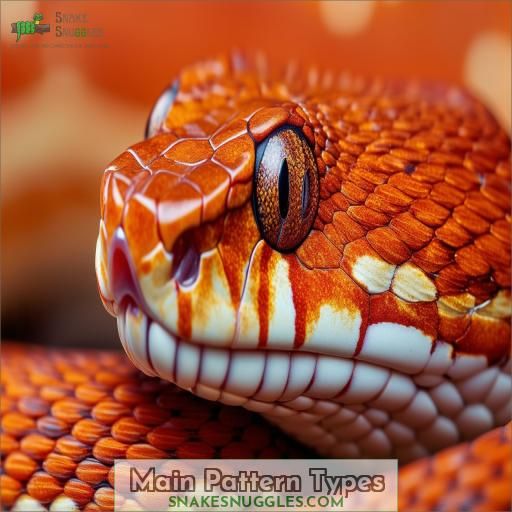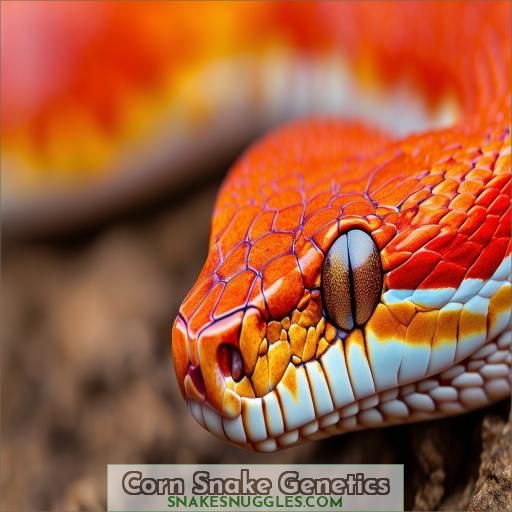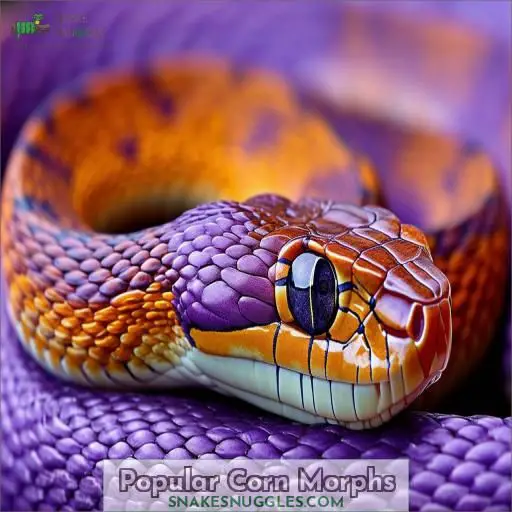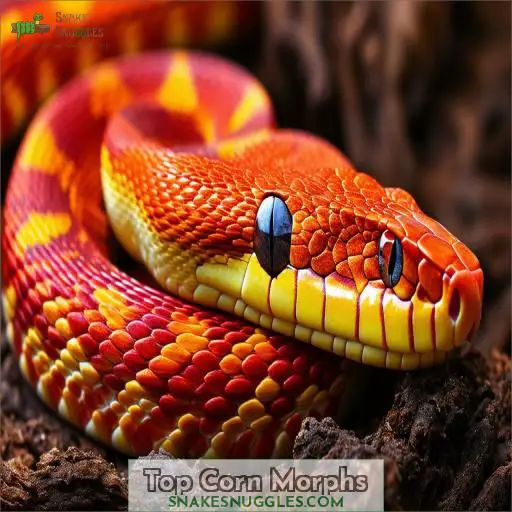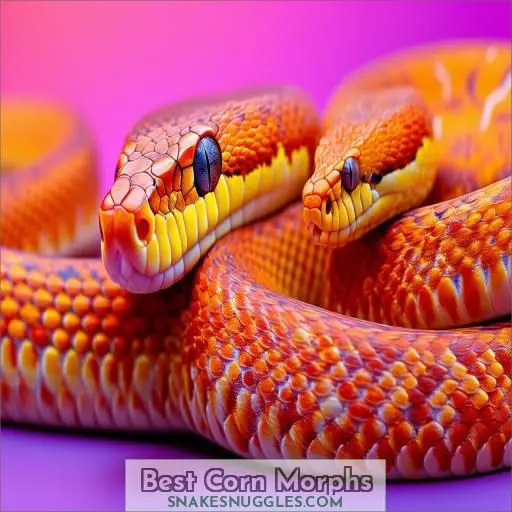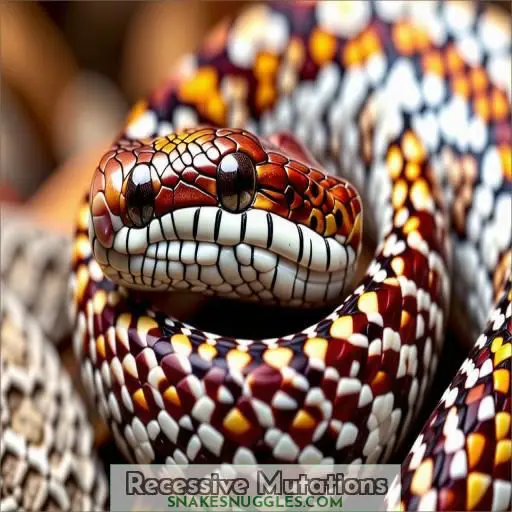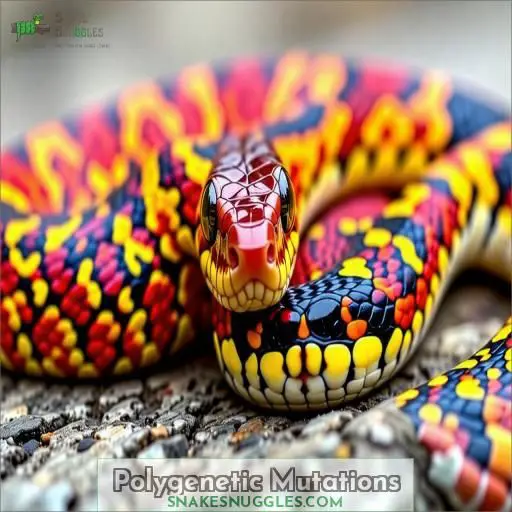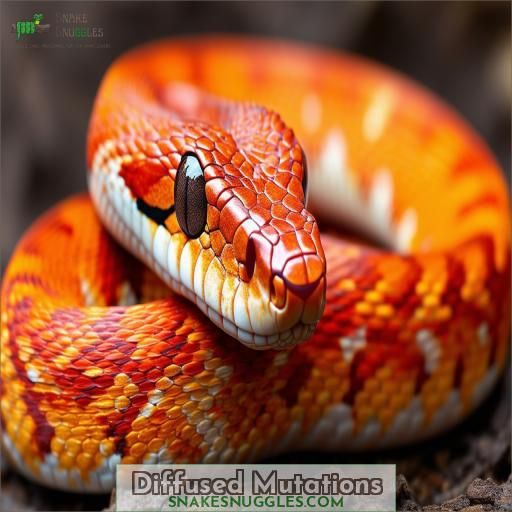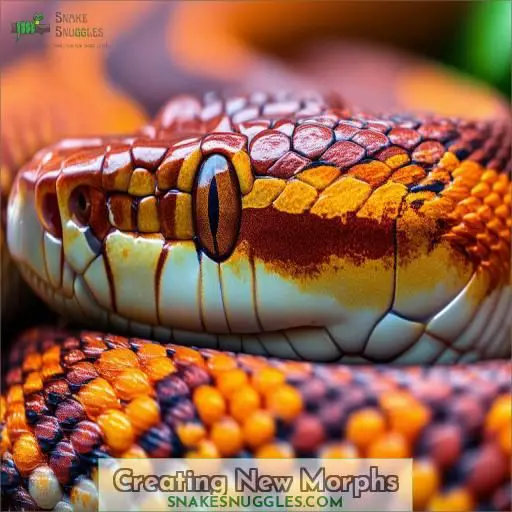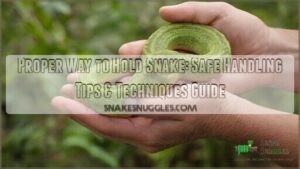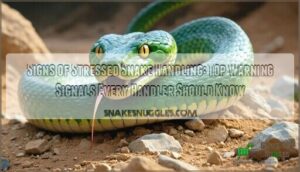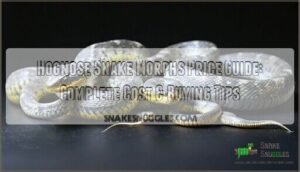This site is supported by our readers. We may earn a commission, at no cost to you, if you purchase through links.
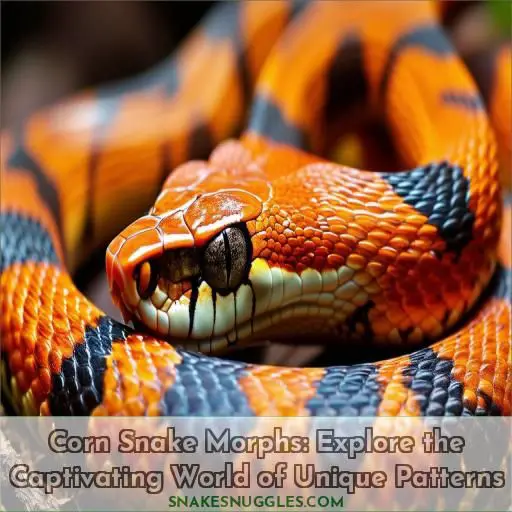 You’re entering an enchanting world where corn snake morphs exhibit nature’s artistic genius. These extraordinary reptiles possess a genetic tapestry adorned with vibrant hues and captivating patterns.
You’re entering an enchanting world where corn snake morphs exhibit nature’s artistic genius. These extraordinary reptiles possess a genetic tapestry adorned with vibrant hues and captivating patterns.
From the traditional saddle markings to the striking zipper pattern adorning their spines, corn snake morphs present a spectacle of visual wonders.
Decipher the enigma of dominant and recessive genes, heterozygous offspring, and genetic intricacies that birth gems like the radiant Okeetee and charcoal hues.
Delve further to discover the boundless beauty that awaits in this domain of slithering marvels.
Table Of Contents
- Key Takeaways
- Corn Snake Morphs
- Main Pattern Types
- Corn Snake Genetics
- Popular Corn Morphs
- Top Corn Morphs
- Best Corn Morphs
- Recessive Mutations
- Polygenetic Mutations
- Diffused Mutations
- Creating New Morphs
- Frequently Asked Questions (FAQs)
- What is the most popular corn snake morph?
- What is an amel corn snake?
- What is a sunkissed corn snake?
- What makes a moonstone corn snake?
- How much do different corn snake morphs cost?
- What are the rarest corn snake morphs available?
- How do corn snake morphs impact their temperament?
- Are certain corn snake morphs more prone to health issues?
- Can corn snake morphs be bred with other species?
- Conclusion
Key Takeaways
- Buckle up, my friend! Exploring the world of corn snake morphs is like embarking on a thrilling treasure hunt, where each unique pattern and dazzling hue is a precious gem waiting to be unearthed. From the fiery caramel to the ghostly anerythristic, these slithering beauties will leave you utterly spellbound.
- Genetics play a crucial role in shaping these mesmerizing morphs. It’s like a grand symphony, where dominant and recessive genes dance together, creating harmonies of color and pattern that would make Mother Nature herself envious. Prepare to delve into the intricate dance of heterozygous offspring and genetic epistasis – the choreographers behind these living works of art.
- Imagine being a master artist, wielding the brush of selective breeding to craft your own masterpieces. Through dedicated breeding programs, herpetoculturists can cross morphs, isolate recessive traits, and even create unprecedented combinations that challenge the boundaries of what’s possible. It’s a canvas where innovation knows no limits.
- Whether you’re a seasoned reptile enthusiast or a curious newcomer, the world of corn snake morphs is a captivating realm that will ignite your senses and fuel your passion. From the striking amelanistic to the ethereal diffused, each morph tells a unique story, inviting you to embrace the boundless beauty that nature has to offer.
Corn Snake Morphs
You’re about to start an exhilarating journey into the realm of corn snake morphs!
Imagine the thrill of mastering the art of morph breeding, revealing captivating color combinations and patterns. From the striking amelanistic and anerythristic variations to the rich caramel hues, each morph boasts a unique genetic tapestry.
Hypomelanistic snakes, with their reduced melanin, offer a stunning display of soft tones.
As you explore this captivating domain, you’ll discover a universe of possibilities, where genetic diversity knows no bounds.
Embrace the challenge of ensuring these exquisite morphs thrive under your care, tailoring their environment to their specific requirements.
Main Pattern Types
Corn snakes exhibit a variety of captivating patterns, including the typical blotched pattern with distinctive saddle-shaped markings.
The motley pattern has a broken and irregular appearance.
The banded pattern features rings encircling the body.
The zipper pattern has a distinctive line down the spine.
The plain pattern is a solid, uniform coloration.
Understanding the genetic mutations that result in unique morphs, such as the Snow and the classic Okeetee, through corn snake colors is essential for appreciating the diverse appearances within the corn snake morph world.
Typical Blotched
As you explore corn snake morphs, the typical blotched pattern stands out with its iconic saddle-shaped markings. Admire the vibrant contrast between the bold, rounded blotches and the snake’s base color. From rich oranges to deep browns, the blotch hues captivate, while their precise placement and sizing create a visually striking display.
Motley
With the motley pattern, you’ll witness a mesmerizing transformation of traditional corn snake markings. Distinct broken-up stripes adorn the snake’s body, creating a unique, attention-grabbing display. Explore the motley corn’s striking genetics, where a simple recessive mutation transforms the familiar into the extraordinary. Discover a world of pattern innovation with this intriguing morph.
Banded
You’ll often find the banded morph showcasing:
- Solid bands wrapped around the snake’s body
- Vibrant colors like orange, red, or yellow
- Striking contrast against the background hue
This distinct pattern arises from selective breeding and a unique genetic interplay. Combinations like bloodred x ultramel or charcoal x okeetee can produce mesmerizing banded varieties.
Zipper
Reveal the ‘Zipper’ pattern, an enchanting subspecies variation! These corn snakes showcase a zipper-like pattern running along their dorsal ridge. Habitat impact on wild populations sparked captive breeding initiatives to protect this wonder.
| Keyword | Description |
|---|---|
| Diffused | Faded patterning, blends seamlessly |
| Lavender | Lilac-gray base, vibrant markings |
Explore the ‘Zipper’ – a witness to nature’s artistry and our commitment to preservation.
Plain
Moving on from zippers, you’ll find plain corns completely lacking patterns—a solid, consistent color throughout. These include:
- Terrazzo: light gray base with faint speckles
- Sunglow: vivid yellow like blazing sunshine
- Fluorescent amel: bright orange that glows under UV light
Plain morphs offer simplicity yet beauty in their uniformity.
Corn Snake Genetics
In corn snake genetics, dominant genes are expressed with only one copy, while recessive genes only show up with both copies. Baby snakes inherit one copy of each gene from each parent, with heterozygous offspring inheriting one copy of each allele.
Dominant Genes
You’ll encounter dominant genes that express their traits if the corn snake inherits just one copy. Codominance and incomplete dominance occur when two different versions interact, creating unique displays like the butter, creamsicle, Miami phase, striped amber, or striped bloodred morphs. Sex-linked genes, gene interactions, and genetic epistasis further influence dominant trait expression.
Recessive Genes
In contrast to dominant traits, you’ll encounter recessive ones when both gene copies exhibit the unique expression. Say goodbye to typical hues, as recessive inheritance often results in pigment loss, revealing striking variations like the striped anerythristic, butter, caramel, fire, and gold dust. Through careful selective breeding, breeders harness these genetic gems, expanding morphological diversity.
Heterozygous Offspring
You create genetic diversity when breeding heterozygous corn snakes. Baby snakes inherit one copy of each gene from each parent. Strategic selective pairings increase the chances of producing unique heterozygous offspring with varied traits. Popular heterozygous morphs include the striped amelanistic, striped ghost, and striped sunglow. Genetic variation, including mutations such as amelanistic mutations, is the fuel driving novel corn snake morph discoveries.
Popular Corn Morphs
Among the popular corn snake morphs, the normal variety exhibits classic features like orange skin, black lines, and red saddle markings.
Morphs like the Alabama, with deep earthy colors and copper brown blotches, the Okeetee, known for its striking beauty and medium brown or deep orange base, the caramel, with vivid caramel hues, and the anerythristic, lacking red, orange, and yellow pigments, showcase the alluring diversity within this species.
Normal
You’re captivated by the normal corn snake’s classic features:
- Orange skin
- Black lines
- Red saddle markings
This wild-type strain showcases the typical blotched pattern. Its natural coloration reflects the corn snake’s origins, making it a cherished variety among enthusiasts seeking authenticity.
Alabama
Immerse yourself in the Alabama corn snake’s rich and earthy hues. Its white belly checkers create a striking contrast against copper brown blotches. This unique color combination offers enticing appeal, while its docile nature and straightforward care make it an excellent choice for corn snake enthusiasts.
| Characteristic | Description |
|---|---|
| Colors | Black, white, copper brown |
| Pattern | Blotches on earthy base |
| Belly | Contrasting white checkers |
| Care Level | Beginner-friendly |
| Price Range | $50 – $150 |
Okeetee
The Okeetee’s striking allure captivates with its medium brown or deep orange base showcasing red or burnt orange dorsal blotches. This eye-catching morph emerged from:
- Wild populations in Florida’s Okefenokee Swamp region
- Selective breeding for vivid coloration
- Isolated gene pools for pattern consistency
- Enthusiast demand for unique morphs
Embrace the Okeetee’s one-of-a-kind beauty through proper habitat setup and care.
Caramel
If the okeetee’s burnt orange and desert tan hues appeal to you, consider the caramel morph. These snakes flaunt vivid patterns and caramel-tinged yellow pigmentation that intensifies with age. Their alluring appearance is an evidence of selective breeding:
| Gene | Trait |
|---|---|
| Caramel | Caramel hues, vivid patterns |
| Wild-type | Orange, black, red saddles |
| Caramel x Wild-type | Variation in color inheritance |
Explore the fascinating world of caramel corn snakes.
Anerythristic
You’re surely captivated by the Anerythristic corn snake‘s unique appeal.
Lacking red, orange, and yellow pigments, these beauties flaunt a pale gray base with striking dark gray blotches.
Through deliberate and selective breeding, breeders have cultivated an array of Anerythristic pattern variations customized to your preference.
With proper care and appropriate feeding, these remarkable serpents make an enthralling addition to any collection.
Top Corn Morphs
Get ready to explore some of the most striking corn snake morphs that captivate reptile enthusiasts around the world. From the charcoal’s muted gray tones and dark blotches to the amelanistic morph’s striking lack of black pigmentation, revealing vibrant oranges and yellows, these top varieties showcase the incredible diversity within this species.
Charcoal
You’re drawn to the charcoal corn snake’s mysterious allure. Its gray hues captivate, while dark blotches add depth. The result of recessive genes, this morph:
- Eliminates yellow pigments
- Sports gray scales
- Displays dark gray markings
- Features black outlines
Absence creates striking presence—the charcoal pattern mesmerizes with its smokey sophistication.
Amelanistic
Moving on from the charcoal morph, you’ll find the amelanistic corn snake particularly striking. These snakes lack melanin, resulting in a vivid white body with orange saddle markings – a recessive trait inherited from both parents. Bloodred amelanistics display a deep crimson hue, while caramel amelanistics showcase warm, toasty tones.
Hypomelanistic
You’re captivated by the hypomelanistic corn snake morph with its striking reduced melanin pigmentation, resulting in:
- Lighter shades of natural colors
- Muted patterns and tones
- Subtle beauty unlike typical morphs
This visually stunning variation arises from selective breeding programs isolating the hypomelanistic gene inheritance. Its unique appeal draws admiration from enthusiasts seeking innovative corn snake varieties.
Cinder
You’ll also find the cinder corn snake an alluring morph. It eliminates yellow, orange, and red pigments, resulting in a brick-red pattern on a grayish hue. With its genetic inheritance isolating specific colors, the cinder’s striking appearance has become a sought-after find among enthusiasts. While still relatively new, this morph’s availability is steadily increasing.
Diffused
The diffused morph boasts faded patterns that seamlessly blend with the snake’s body colors, creating a striking lack of contrast. You’ll marvel at the subtle gradations from one hue to the next, as if nature itself painted these snakes with a masterful touch. Embrace the allure of diffused corn snakes, where patterns gracefully merge into exquisite color harmony.
Best Corn Morphs
Behold the striking striped corn snake, adorned with clear stripes upon a dark background. The topaz motley corn snake captivates with its amber hues and motley pattern that removes the dark patches.
Striped
The striped corn snake exhibits a striking appearance with clear, defined stripes against a dark background. You’ll be captivated by its unique pattern and vibrant hues. This morph requires the same care as other corns, thriving in a secure habitat with proper temperatures and humidity. Uncover the fascinating genetics behind this eye-catching variation.
Topaz Motley
If you long for a vibrant, amber-hued beauty, the topaz motley corn snake delivers with its golden coloring and distinctive motley pattern. Careful breeding practices combine the recessive motley gene with other desirable traits to create unique color combinations. This morph’s mesmerizing pattern inheritance guarantees each snake is an enthralling work of art.
Sunkissed Ultramel
The sunkissed ultramel, much like its name suggests, resembles a natural variety but with brighter colors. Little dark brown or black adorns this beauty, as vivid yellows and rich ambers take center stage. Caring for this baby means providing the perfect vivarium setup—ideal temperatures, proper hides, and a feeding schedule every 5-7 days.
Buck Skin Okeetee
With the Buck Skin Okeetee morph, you’ll be captivated by its striking desert sand tan base adorned with burnt orange markings. This Okeetee lineage showcases a black and white checkered underbelly, adding contrast to its mesmerizing pattern. Unleash this gem to reveal its full genetic potential.
Blizzard
The Blizzard morph captivates with its striking white body and red eyes. They’re quite active, so make sure to provide a spacious enclosure. Feed frozen/thawed mice sized appropriately every 5-7 days. With proper care, Blizzard corns make hardy, inquisitive pets living 15-20 years. Expect to pay $100-$300 from reputable breeders for a healthy hatchling.
Recessive Mutations
Among the most well-known recessive mutations in corn snakes are the amelanistic (amel) and anerythristic (anery) varieties. The amelanistic mutation results in a complete lack of black pigment, producing snakes with bright yellow, orange, and red hues, while anerythristic cornsnakes exhibit an absence of red and yellow pigments, creating grayish snakes with charcoal or sepia saddles.
Amelanistic (Amel)
You’ve likely encountered amelanistic corn snakes, with their striking white bodies adorned by vibrant orange saddles. This recessive mutation causes:
- Complete lack of melanin pigment
- Pale pink or reddish eyes
- Alluring albino-like appearance
Amelanism differs from albinism, as amelanistic snakes still produce other pigments like red and yellow. Their genetic makeup makes them both beautiful and fascinating to reptile enthusiasts.
Anerythristic (Anery)
Another breathtaking recessive morph is the Anerythristic, lacking red, orange, and yellow pigmentation. These snakes possess a unique, pale gray base color with dark gray blotching, offering a striking contrast. Unraveling their genetic isolation through selective breeding has revealed captivating color variations:
| Typical Anerythristic | Granite Anerythristic | Ghost Anerythristic |
|---|---|---|
| Pale gray base, dark gray blotches | Warm brown tones, reduced pattern contrast | Ghostly pale appearance, faint patterning |
Polygenetic Mutations
The bloodred morph is a polygenetic mutation, meaning its phenotype arises from interactions between multiple genes. While recessive mutations like amel and anery follow simpler inheritance patterns, polygenetic traits require specific gene combinations inherited from both parents.
You’ll find bloodreds emerging sporadically in the wild, as random genetic shuffling occasionally yields the right combo. But controlled breeding allows herpetoculturists to reliably produce bloodreds by pairing snakes carrying the requisite alleles.
Creative genetic combinations underlie the dizzying variety of corn snake morphs. Bloodred serves as a prime example of innovative breeders harnessing polygenetic traits to expand the spectrum of alluring patterns.
Diffused Mutations
You’ve learned about polygenetic mutations like bloodred; now let’s explore diffused mutations, which impact color distribution across a corn snake’s body. These fascinating genetic quirks create diffused patterns, where distinct markings blend seamlessly into surrounding hues, yielding:
- Soft, ethereal appearances
- Muted, watercolor-like effects
- Unique, one-of-a-kind looks
- Varied expressions within the same morph
- Unparalleled visual interest and appeal
Diffused morphs showcase nature’s artistry, with colors and patterns melding in unexpected ways. These snakes are true masterpieces – living embodiments of innovation through subtle genetic variation. Their diffused beauty captivates both seasoned and novice reptile enthusiasts alike.
Creating New Morphs
When aiming to create new corn snake morphs, you can establish dedicated breeding programs focused on isolating and stabilizing desired traits. Once a recessive trait produces homozygous offspring reliably displaying the mutation, you can cross these unique morphs into existing bloodlines to expand the variety even further.
Breeding Programs
Breeding programs are the foundation of morph development, carefully curated to foster genetic diversity and lineage preservation. Through ethical practices, breeders selectively pair desired traits, pioneering groundbreaking corn snake varieties that allure enthusiasts worldwide.
| Ethics | Genetic Diversity | Lineage |
|---|---|---|
| Humane | Novel Traits | Ancestry |
| Welfare | Unique Combinations | Heritage |
| Respect | Expanded Gene Pool | Roots |
Homozygous Recessive
To create a stable homozygous recessive morph, you’ll need to produce offspring that inherit two copies of the recessive trait from each parent. This breeding strategy guarantees the desired genes are locked in, allowing you to reliably produce that specific morph.
With homozygous recessives, you gain trait stability and preserve genetic diversity—key factors in developing alluring new corn snake varieties.
Crossing Morphs
By crossing morphs, you release a world of new variations and unique appearances. Imagine the possibilities: a homozygous recessive line combined with another, yielding an array of novel combinations. The results could be:
- Vibrant hues unseen before
- Patterns that captivate the eye
- Traits that defy expectations
- Creations that ignite your passion
Embark on this journey of innovation, where the boundaries of what’s possible are ever-expanding.
Frequently Asked Questions (FAQs)
What is the most popular corn snake morph?
As you gaze into the vivid, crystalline patterns of a slithering rainbow, the amelanistic Sunkissed morph reigns supreme – a dazzling vision of vibrant oranges and vivacious yellows.
What is an amel corn snake?
An amel (amelanistic) corn snake is a bright morph where the snake lacks black pigment, resulting in a vibrant red, orange, and yellow coloration.
What is a sunkissed corn snake?
A sunkissed corn snake boasts vivid hues with a warm orange base and strikingly bright yellow saddles. This eye-catching morph exudes radiance, its bold coloration shining like a sunbeam’s kiss.
What makes a moonstone corn snake?
A moonstone corn snake has a striking metallic silver base color with smoky black markings. Its shimmering appearance results from a combination of the charcoal and anery mutations, creating a mesmerizing lunar glow.
How much do different corn snake morphs cost?
Corn snake morph prices vary considerably. You may find affordable hatchlings for $25, but rare designer morphs can reach $500 or more. Pricing depends on uniqueness, availability, and breeder reputation.
What are the rarest corn snake morphs available?
Like priceless jewels, the rarest corn snake morphs dazzle with their singular beauty – the coveted Granite Burmese and the mesmerizing Ultramel Caramel Albino.
How do corn snake morphs impact their temperament?
You’ll be glad to know that corn snake morphs don’t impact temperament. Their personality is determined by genes and how they’re handled—morphs mainly affect aesthetics like color and pattern. With proper care, any corn snake can make a great pet.
Are certain corn snake morphs more prone to health issues?
Yes, certain corn snake morphs can be prone to specific health issues. For example, amelanistic and anerythristic morphs may face vision problems due to lack of pigmentation. It’s essential to research each morph’s potential concerns and provide proper care.
Can corn snake morphs be bred with other species?
You’re like a talented chef, crafting culinary masterpieces. Regrettably, cross-breeding corn snakes with other species is genetically impossible – they can only interbreed within their own species to create tantalizing new morphs.
Conclusion
Ultimately, corn snake morphs represent an alluring universe where genetic artistry manifests in vibrant patterns. With over 500 documented morphs, these slithering beauties showcase nature’s limitless creativity, from the radiant Okeetee to the smoky Charcoal. Traverse this ever-changing tapestry, where dedicated breeders continually introduce novel corn snake morphs, each a testament to the wonders of genetic variation.

